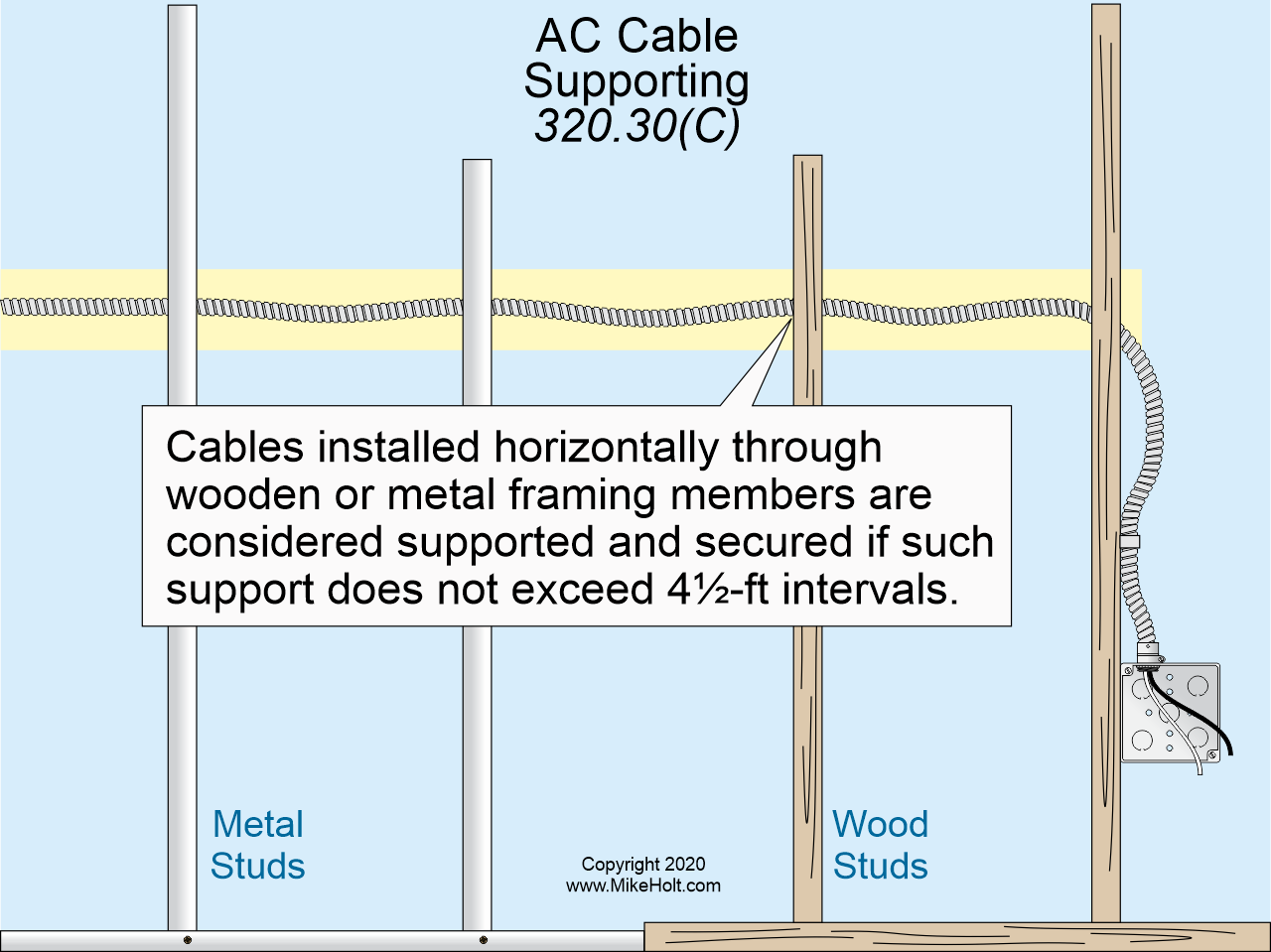|
For EC&M Magazine
By Mike Holt, NEC® Consultant
Here's the follow-up to yesterday's newsletter.
This includes the answers to the questions sent, so you can see how you did.


Figure 01
|
 |
|
Figure 01
|
For EC&M Magazine
By Mike Holt, NEC® Consultant
Here's the follow-up to yesterday's newsletter.
This includes the answers to the questions sent, so you can see how you did.

Note: The answers to these questions are based on the 2020 NEC.
Q1: What are the NEC requirements when installing MC cable in accessible attics or roof spaces?
A1: 330.23 In Accessible Attics or Roof Spaces
Type MC cable installed in accessible attics or roof spaces must comply with 320.23.
Author's Comment:
â–ºOn the Surface of Floor Joists, Rafters, or Studs. In attics and roof spaces that are accessible, substantial guards must protect cables installed across the top of floor joists, or across the face of rafters or studding within 7 ft of the floor or floor joists. If this space is not accessible by permanent stairs or ladders, protection is required only within 6 ft of the nearest edge of the scuttle hole or attic entrance [320.23(A)].‚
Author's Comment:
â–ºAlong the Side of Framing Members [320.23(B)]. When Type MC cable is installed on the side of rafters, studs, or floor joists, no protection is required if the cable is installed at least 1¼ in. from the nearest edge of the framing member where nails or screws are likely to penetrate [300.4(D)].
Q2: What is the minimum bending radius of MC cable?
A2: 330.24 Bending Radius
Bends must be made so the cable will not be damaged, and the radius of the curve of any bend at the inner edge of the cable must not be less than that dictated in each of the following instances:
(A) Smooth-Sheath Cables
(1) Smooth-sheath Type MC cables are not permitted to be bent so the bending radius of the inner edge of the cable is less than 10 times the external diameter of the metallic sheath for cable up to ¾ in. in external diameter.
(B) Interlocked- or Corrugated-Sheath Armor. Interlocked- or corrugated-sheath Type MC cable is not permitted to be bent so the bending radius of the inner edge of the cable is less than seven times the external diameter of the cable.‚
Q3: What are the requirements for securing and supporting MC cable?
A3: 330.30 Securing and Supporting
(A) General. Type MC cable must be supported and secured by staples; cable ties listed and identified for securing and supporting; straps, hangers, or similar fittings; or other approved means designed and installed so the cable is not damaged.‚Figure 01
Author's Comment:
â–ºSecured means Fastened such as with a strap or tie wrap; supported means Held such as with a hanger or run through a hole in a stud, joist, or rafter.‚
(B) Securing. Type MC cable with four or fewer conductors sized no larger than 10 AWG must be secured within 12 in. of every outlet box, junction box, cabinet, or fitting and at intervals not exceeding 6 ft.‚
(C) Supporting. Type MC cable must be supported at intervals not exceeding 6 ft. Cables installed horizontally through wooden or metal framing members are considered secured and supported if such support does not exceed 6-ft intervals.
(D) Unsupported Cables. Type MC cable can be unsupported and unsecured where:
(1) Fished through concealed spaces in a finished building and support is impractical.
(2) Not more than 6 ft long from the last point of cable support to the point of connection to a luminaire or electrical equipment within an accessible ceiling. For the purposes of this section, Type MC cable fittings are permitted as a means of cable support.‚
(3) Not more than 3 ft from the last point where it is securely fastened to provide flexibility for equipment that requires movement after installation, or to connect equipment where flexibility is necessary to minimize the transmission of vibration from the equipment.‚
Q4: What are the conditions TC cable can be used and installed?
A4: 336.10 Uses Permitted
Type TC cable is permitted to be used:
(1) For power, lighting, control, and signaling circuits.
(2) In cable trays including those with mechanically discontinuous segments up to 1 ft.
(3) In raceways.
(4) In outdoor locations supported by a messenger wire.
(5) For Class 1 circuits in accordance with Article 725.
(7) Between a cable tray and equipment if it complies with 336(10)(7).
(8) In wet locations where the cable is resistant to moisture and corrosive agents.
(9) In one- and two-family dwellings, Type TC-ER-JP cable is permitted for branch circuits and feeders where installed in accordance with Part II of Article 334 for interior wiring, and Part II of Article 340 for exterior wiring.
Author's Comment:
â–ºThe ER marking on Type TC-ER cable identifies it as suitable for exposed run use in accordance with UL and the suffix -JP identifies it as being suitable for pulling through wood framing members.
Ex: Where Type TC cable is used to connect a generator and its associated equipment, the cable ampacity limitations of 334.80 and 340.80 do not apply.
Author's Comment:
â–ºThe JP marking on Type TC-ER-JP cable identifies it as suitable to be pulled through wood framing members because the cable has met the joist pull testing requirements of UL.
(10) Direct buried where identified for direct burial.
|

